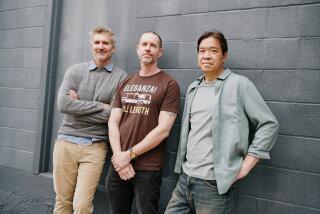Paintings, Text Speak of the ‘Trauma’ in China’s Body Politic
- Share via
SAN DIEGO — The body politic is not just a figure of speech but a metaphor as old as the oldest cave clan. In a striking series of wall paintings and texts at Sushi (852 8th Ave.), Hung Liu brings the metaphor up to date by applying it to the present situation in China. The country, she asserts, is ill. A living, organic entity, it has lost its sense of balance and stumbled into a state of disease.
“Trauma,” the name of Liu’s show, contains few concrete references to the violent suppression of student demonstrators in Tian an Men Square last June. Liu, a Chinese artist who attended UC San Diego and now teaches art in Texas, doesn’t spell out her opposition to the government’s actions in literal terms. She avoids particularities and instead presents a philosophical framework in which to interpret these recent events. The scheme she offers derives from Taoist philosophy and traditional Chinese medicine: the concept of yin and yang.
“The balance between these two primordial cosmic forces is viewed as the key factor in all natural phenomena and life processes,” she writes on one wall. Yin and yang depend on one another; their balance signifies health and well-being for the individual and society alike.
Liu further explains in her wall text that these forces are not static. Everything is relative, flexible, changing. Both yin and yang “contain the germ of their own opposite within themselves,” and when one pushes the limits of its own definition too far, it “transmutes” into the other. Thus the revolutionaries of one generation become another’s stolid bureaucrats.
Liu erects this conceptual scaffolding with deft and dramatic brush strokes, painted directly on the gallery walls. The immediacy of her approach and her stark palette of red, white and black lend the imagery an engaging clarity, but more is needed--perhaps an explanatory text apart from the paintings--to give the non-Chinese viewer access to the work’s symbolism.
Looming figures of a rat and rabbit, for instance, guard the entrance to the show. Familiar players in the zodiac cosmology, the animals also are believed to guard against sickness and bad fortune. Less apparent, though highly significant to their context here and explained privately by the artist, is the animals’ guardianship over certain hours of the day. By presenting the rat, guardian of late night hours, with the rabbit, protector of the early morning, Liu has framed the span of time during which the massacres occurred in Tian An Men Square--the span, she explained, during which no protection was provided.
Amid Chinese and English texts on another wall, Liu repeats an image of three hands in slightly varied formations. Though this, too, is not clear simply on sight, these diagram the preferred methods of taking one’s pulse, in Chinese medicine the primary indicator of physiological distress.
Other paintings in the installation convey the metaphor linking the body and the state more explicitly through the layering of distinct but conceptually related images. A map of central Beijing overlaps an illustration of a man, seen from the front and back, with his acupuncture points marked and labeled. Liu here draws a vivid parallel between the body’s centers of energy and the city’s, both sites of trauma when the system malfunctions.
In a facing image, symbols of liberty flicker lithely around a painting of a woman with bound feet. The woman stares numbly ahead, her ritualistic repression finding its release in the expansive gestures of the Statue of Liberty and the allegorical image of “Liberty Leading the People” from the painting of the same name by Eugene Delacroix. Both the American and the French symbols served as inspiration to the students demonstrating in China.
Liu weaves an intelligent and provocative web of words and images in “Trauma,” punctuating the paintings with wood cutouts of a figure practicing Tai Chi, striving for the balance, grace and stability aspired to equally by individuals and nations.
A gentleness and even a sadness pervade the installation, where one would expect to find angry indictments. The installation thus takes one of the richest tacks that politically oriented art can take. By casting a familiar subject in a radically new guise, it invites new and differing interpretations. Neither prescriptive nor propagandistic, Liu’s work envelops the viewer in fresh ideas and functions as a catalyst for further thought.
Although Sushi’s visual arts programming has often been ambitious, few artists have been able to unify and activate the gallery’s awkward exhibition space as effectively as Hung Liu. Her show continues through Oct. 14.
More to Read
The biggest entertainment stories
Get our big stories about Hollywood, film, television, music, arts, culture and more right in your inbox as soon as they publish.
You may occasionally receive promotional content from the Los Angeles Times.










